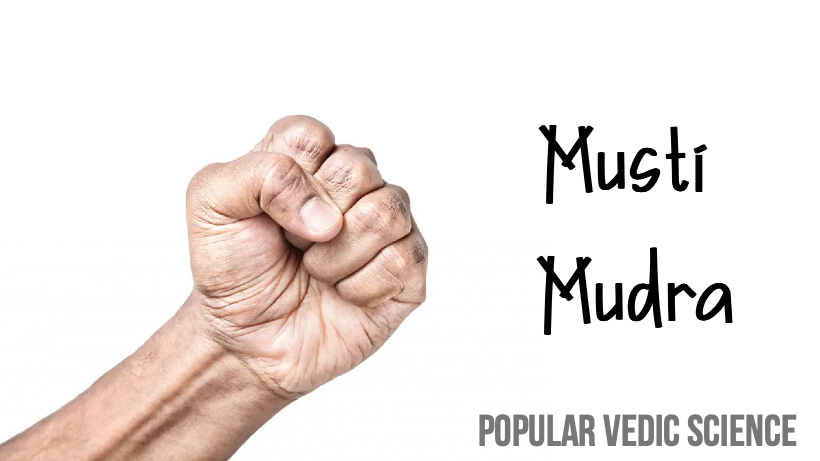
Musti means fist, and Musti mudra means to make a fist. We make a fist when we want to let out our emotions. Pressure on the hands activates a large brain area, creating positive pressure. We can also observe this when we exercise that we empty our minds and improve our thoughts or throw the stress out of our body and mind. Musti mudra similarly creates a positive pressure in which just a pressure cooker lets out steam, and it lets out our pent-up emotions and stresses.
In this article, we provide a deep look at how to perform the Musti Mudra, as well as its numerous benefits and important precautions.
What are Mudras?
Mudras are hand gestures that activate a certain element or energy in the body. The five fingers represent the five elements. The energy activation point lies on the fingertips. When the fingertips are connected, the subtle energy in your body gets activated. The thumb represents the fire element. This element represents agni within the body, and it serves to activate all the other elements.
The index finger represents air, middle finger ether, ring finger earth and the little finger represents the water element.
When different hand formations, or mudras, are formed, the combination of subtle elements has a powerful effect on the mind and body.
How Can Mudras Heal?
There is a spiritual force that mediates our mind-body connection. Ayurveda says that when the elements in our body are balanced, our bodies and minds are healthy. Whenever imbalance arises, we can attain balance by activating specific elements using various mudras. Acupuncture is another method that involves activating specific points in the body and improving the flow of energy. Mudras act in a similar way. The tips of our fingers act like electrical potential points, and when the mudras are formed, they create an electrical circuit that circulates energy throughout the body. As this energy circulates, we feel a healing effect. The most astonishing fact is that our brain uses about 60% of its surface area to process the movements and sensations of the hands.
RECOMMENDED: For a complete guide to the many mudras and their benefits, check out Healing Mudras: Yoga of the Hands by Yogi Nataraj.
How to Perform the Musti Mudra?
Closing all fingers and covering them with the thumb is called Musti mudrā. This mudra is best performed when we feel emotional or stressed. Just hold this mudra and take a quiet walk, relax your brain and quietly release your emotions. You can even take a walk after lunch with this mudra, and it can also improve digestion. Deep breathing will enhance the effects of this mudra.
When Should I Perform the Musti Mudra?
The Musti Mudra is useful for:
- Releasing emotions
- Releasing anger
- Calming the mind
- Treating depression and lack of enthusiasm
- Finding clarity in your thoughts
- Improving digestion
- Reducing anger and frustration
- Enhancing the renal glands
- Relaxing the muscular system
Precautions When Practicing Musti Mudra
It is essential to relax your breathing while performing this mudra. We should avoid holding too tight; pressure should be medium and calm breathing will ensure good results. Do not rush your breathing. Try to be as relaxed as possible.
Suggested Sequence
- Sit in a comfortable position.
- Join your hands in a prayerful, meditative position.
- Straighten your back.
- Close all fingers and cover them with the thumb as shown.
- Hold the Musti Mudra for 10-20 minutes.
- Practice Prana Mudra for 10 minutes.
- Join your hands together and end with a prayer.
What Chakras Does Musti Mudra Activate?
Musti mudra activates the third eye chakra and the crown chakra as these chakras relate to relaxation, inner healing and clearing of thoughts. If we focus on the forehead region, we can experience the energy on the forehead.
Related Mudras
The following are all complimentary mudras:
- Adi Mudra
- Samana Mudra
- Gyan Mudra
- Brahma Mudra
Related Yoga Poses
The following yoga poses will give similar effects as Musti Mudra: Simhasana (Lions pose), Vajrasana (Diamond pose), Halasana (Plough pose), and Paschimottanasana (seated forward bend). Marichayasana ((Pose Dedicated to the Sage Marichi I), Mayurasana (peacock pose).
List of Mudra Guides
Mudras are very beneficial when performed with proper understanding. Mudras deal with individual elements, combinations of elements, the vital airs, the vital functions and even moods and feelings. Regular practice of each mudra based on our needs and present condition can help us achieve the specific results we are looking for. Please explore our various mudra guides and try out the practices that suit your needs
Chakra Mudras
- Mudras for the Root Chakra
- Mudras for the Sacral Chakra
- Mudras for the Navel Chakra
- Mudras for the Heart Chakra
- Mudras for the Throat Chakra
- Mudras for the Third-eye Chakra
- Mudras for the Crown Chakra
Mudra Sequences
Individual Mudra Guides
- Abhaya Mudra
- Adi Mudra
- Agni Mudra
- Akasha Mudra
- Anjali Mudra
- Apana Vayu Mudra
- Bhumisparsha Mudra
- Brahma Mudra
- Dharmachakra Mudra
- Dhyan Mudra
- Ganesha Mudra
- Gyan Mudra
- Kundalini Mudra
- Lotus Mudra
- Prana Mudra
- Prithvi Mudra
- Rudra Mudra
- Shakti Mudra
- Shankha Mudra
- Shunya Mudra
- Surya Mudra
- Udana Vayu Mudra
- Uttarabodhi
- Varada Mudra
- Vayu Mudra
- Vitarka Mudra
- Yoni Mudra